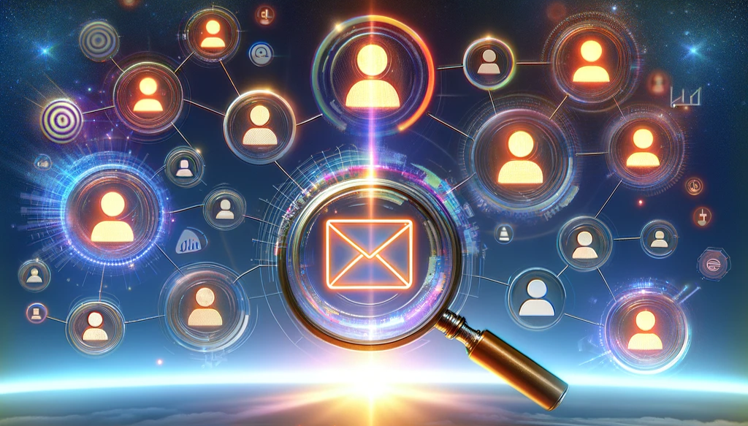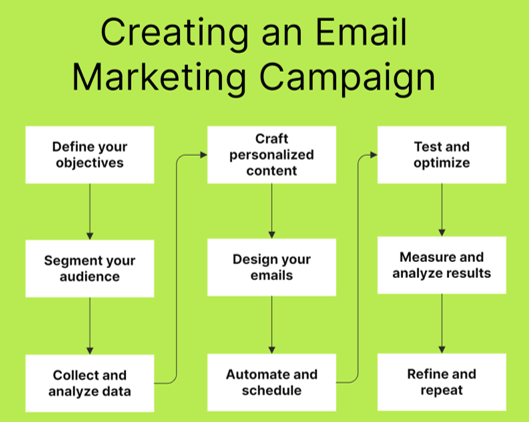
Targeted email marketing is a strategy based on sending personalized and relevant emails to well-defined groups of subscribers. This grouping of subscribers is not at all random. It is guided by key factors such as demographics, purchase behavior, and interaction with the brand.
The goal of such an email is to be relatable to subscribers. Targeted emails work towards building stronger relationships with clients. And they do so much more effectively than one-size-fits-all email campaigns.
Benefits of Targeted Email Marketing
Anyone with an email receives lots of content daily. Standing out in a crowded inbox is a real challenge. But you can significantly increase the chances of your email being opened if you take the time to personalize it.
1. Enhanced engagement rates
Better engagement rates are one of the most compelling benefits of targeted email marketing. When readers receive emails that are related to their interests, needs, or past behaviors, something magical happens. They are far more likely to open, read, and interact with the content. This heightened engagement isn’t just about numbers. A much more important consequence is a stronger and more confident relationship with your subscribers.
2. Improved conversion rates
Another standout benefit are improved conversion rates. With targeted email marketing, every email is made to resonate with a specific audience group. As these emails are highly personalized, they are also highly relevant. And this relevance makes your readers much more inclined to make a purchase, sign up for a webinar, download a whitepaper, etc.
3. Increased ROI
Another important advantage is the increased ROI. The precision of targeted email marketing leads to more efficient use of marketing resources. This precision leads to a higher return on investment (ROI). When you send relevant messages to a well-defined audience, you are cutting a lot of “wastage” that comes with broad-spectrum campaigns. This efficiency saves a lot of time and money and makes your marketing efforts more profitable.
4. Better customer retention
Another key benefit is better customer retention. Sending personalized messages is an important signal to your customers. It shows that you understand them and, most importantly, value their relationship with your brand. And when someone feels appreciated, they are more likely to stick around. As a result, you get to build a strong, long-term relationship with your audience.
5. Insights into customer behavior
Targeted email campaigns are a great source of important data. Marketers can then analyze this data and learn more about customer behavior. They can look into customers’ preferences, buying habits, and engagement patterns. These insights are very useful when refining a marketing strategy.
But it doesn’t stop here. The insights you get from targeted emails can inform other areas of your business too. And data-driven decisions can make every commercial interaction you engage in more personalized and effective
6. Segment-specific messaging
When you target your messages for specific groups, you make all your communications more precise. You get to address unique concerns, questions, or interests of different parts of your audience. This makes your emails far more effective and relevant.
7. Competitive advantage
When you take the time to truly understand your customers and look into their needs and preferences, you set your brand apart. Now, your clients know that you are not taking them for granted. You are making an effort to respond to their expectations. At a time when many of your competitors are still using generic communication, this personal approach is invaluable.
Creating an Email Marketing Campaign
To create a targeted email campaign that works, you will need a good strategy. And to build a good strategy, you first need to understand your audience, get some data, and use it to make your emails relatable.

Let’s discuss each step in detail.
Step 1: Define your objectives
Before you launch a campaign, make sure you know exactly what you want to achieve. Maybe you are looking to increase sales? Or, you want more people to register for your upcoming event? What you pick as your goal will guide the structure, content, and metrics of your campaign.
Step 2: Segment your audience
Next, segment your audience. Take a closer look at your email list and divide it into distinct groups. Use criteria such as demographics, purchase history, engagement level, or other relevant data.
Step 3: Collect and analyze data
Data is your best ally in understanding your readers and building a personalized campaign. You can collect lots of valuable information from sign-up forms, customer interactions, purchase histories, and other touchpoints.
Once you analyze this data, you will be rewarded with valuable insights – and these are what you need to refine the content and timing of your emails.
Step 4: Craft personalized content
So, you have your audience segments, and you have your insights. Now, you can start working on personalized email content. For this, you will need a persuasive subject line, personalized email body text, appealing product recommendations, and customized CTAs.
Step 5: Design your emails
When it comes to visual appeal, your emails should be easy to read and optimized for mobile devices. We say this a lot here — but most people do read their emails on mobile phones. Use a responsive template that will make your email look great on a device of any size.
Step 6: Automate and schedule
There are lots of automation tools that can help schedule your emails and create triggered campaigns. The triggers can be specific actions: for example, welcome emails for new subscribers, re-engagement emails for inactive users, etc.
Step 7: Test and optimize
Before you launch your campaign, look into A/B testing. Try it with elements such as subject lines, email copy, and CTAs. This can help you find out what your audience responds to best. Use this gained knowledge to optimize your emails for higher open rates, click-through rates, and conversions.
Step 8: Measure and analyze results
After your campaign is live, track key performance indicators (KPIs) such as open rates, click-through rates, conversion rates, and unsubscribe rates. Analyze the data to understand what worked and what didn’t. This analysis will provide valuable insights for refining future campaigns.
Step 9: Refine and repeat
Watch how your campaigns do and make the necessary adjustments. Continuous refinement is key to building a stronger and more effective campaign over time.
Targeted Email Marketing Examples
Let’s explore some real-life examples of how targeted email marketing can be implemented across various dimensions such as behavior, gender, and geography.
Behavioral targeted campaign: Amazon’s product recommendations
Amazon sets the gold standard for behavioral targeted email marketing.
Amazon starts by looking into a customer’s browsing history, purchase records, and item ratings. It will then curate a selection of products that the customer is likely to be interested in.
For example, if you have recently searched Amazon for running shoes, you might receive an email giving you a quick overview of similar athletic wear or accessories.
- Key takeaway: Leveraging customer behavior data can help write highly personalized and relevant email content. And when an email is relevant, it has better chances of bringing you conversion.
Gender-based targeted campaign: Sephora’s tailored beauty tips
Sephora is great at creating gender-based targeted email campaigns. They send personalized beauty tips, product recommendations, and exclusive offers that match the specific interests of their male and female subscribers. For example, female subscribers might receive emails about the latest in skincare and makeup trends.
And male subscribers receive content focused on grooming and men’s skincare products.
- Key takeaway: Understanding the gender preferences of your audience will let you tailor your messaging and product recommendations. And this will enhance the overall relevance and appeal of your email campaign.
Geo-based targeted campaign: Weather-triggered promotions by clothing retailers
Clothing retailers often send weather-triggered promotional emails, which are based on the subscriber’s location.
For example, a retailer might send a targeted email about raincoats and umbrellas to those who are currently based in areas with rainy weather. But for subscribers lucky enough to be in warm weather, the same company may send out a promotional message for sunglasses and swimwear.
- Key takeaway: Geo-targeting is another effective way to tailor emails. Knowing the local context that your subscribers find themselves in is a good way to make your marketing efforts more relevant.
The Future of Targeted Email Marketing
As we move further and further down the digital whirlpool, targeted email marketing keeps evolving. It adapts to new technology and changing consumer behaviors. This evolution redefines how brands connect with their audience and shifts the focus towards providing value and respecting privacy.
1. Advanced personalization through AI and machine learning
The future of targeted email marketing definitely includes an intelligent use of artificial intelligence (AI) and machine learning technologies. These tools can help marketers take segmentation and personalization to remarkable new levels. With them, brands can learn to predict customer behavior, automate content customization, and send emails at the optimal time for each recipient.
For instance, Netflix uses AI to personalize email content with movie and TV show recommendations based on individual viewing habits. This level of personalization ensures that each email feels uniquely tailored to the recipient, significantly enhancing engagement and loyalty.
2. Integration of email marketing with omnichannel strategies
Targeted email marketing is often integrated with other channels. In fact, there is a strong focus on offering a seamless customer experience across all platforms. To accomplish this, brands use data from social media, websites, and offline interactions to create a comprehensive customer view.
For example, if a customer adds a product to their cart on a website but doesn’t complete the purchase, a targeted email can be sent to remind them of the item, perhaps with a special offer to encourage completion of the purchase. This omnichannel approach ensures that email marketing is not an isolated channel but a cohesive part of the broader customer experience.
3. Emphasis on privacy and consent
With rising concerns over data privacy and regulations like GDPR and CCPA, the future of targeted email marketing will focus more on privacy and consent. Marketers must be transparent about how they collect, use, and store data.
Brands will leverage zero-party data – meaning that they will only use the data that the customers intentionally shared with the brand to personalize emails. This ensures that marketers are not compromising their readers’ privacy.
To Sum Up
As we look ahead, targeted email marketing gets more nuanced and complex. Marketers will need to learn to balance innovation with ethics, personalization with privacy, and automation with staying authentic.